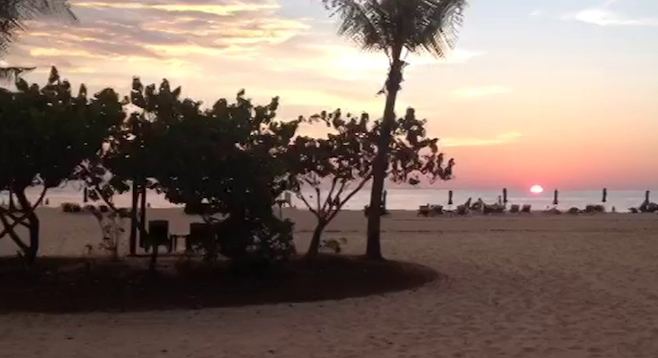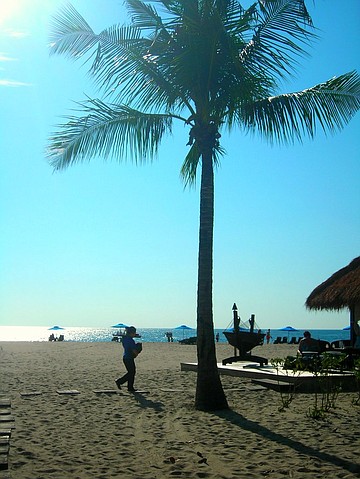 Facebook
Facebook
 X
X
 Instagram
Instagram
 TikTok
TikTok
 Youtube
Youtube

In Tuaran, hidden amidst the nature reserve, half an hour north of Sabah’s capital, Kota Kinabalu, there's a little slice of paradise.

“Be careful!” warned the Kadazan gardener, gripping a long wooden stick, his outstretched hand keeping us at bay. Rhythmically, he speared the stick into the hedge as we all watched in confusion. Before I knew what was happening, a cobra emerged from the beaten bush. Fearlessly, typical of all the Kadazan people we encountered, the gardener quickly snared the fleeing creature and sealed it in a container.
I breathed a sigh of relief. It was even easier to imagine Pantai Dalit Beach, home to the Shangri-la Rasa Ria Resort where we were staying, as a backdrop to that garden from biblical lore.
Sabah's landscape cradles the verdant mountains humpbacked by imposing Mount Kinabalu, Southeast Asia’s tallest peak. Jungles drop down to long windswept powdery beaches, the sea spreads out in a moody canvas of turquoise and pale shades of blue.
Many locals describe it as rasa ria, or “the taste of happiness.” To us, my travel partner and I, it was our Malaysian Eden.

Amidst this 400-acre swath of tropical forest, we were joined by other escaping tourists – families celebrating reunions, business travelers on break, newlyweds on honeymoon. Under the spell of the sea and the mountain, everybody succumbs. It’s easy to become aimless here when walking the three-kilometer stretch of sand.
We did eventually make it off the beach, hiking to a nearby rainforest where a guided tour offered a close encounter with Borneo’s icon: the orangutans.
Twice daily, a ranger from the hotel escorts a small group to view the orangutans in the wild. The only one of its kind on the west coast of Sabah, the nature reserve is intended for nature conservation and orangutan rehabilitation. A nearby tree-top canopy walkway offers another adventure, as hornbills and other tropical birds glide overhead.
If the jungle feels claustrophobic, the sea is its opposite – an endless open space. You can jet ski or parasail, but underneath is where the real excitement lies.
Diving sites are close by, with a dive center in Pulau Gaya, the largest island in the Tunku Abdul Rahman National Park. Islands, atolls and cerulean waters make up this park that spreads over 4,929 hectares, two-thirds of which is water. With abundant reefs and sea life, it’s perfect for scuba diving and snorkeling.
As the sun sets, a soft burst of crimson, pink, violet and orange illuminates the sky, blanketing the landscape as the last rays vanish before our eyes.
It was all too soon, but with cocktails, over a mouth-watering Malay char-kway-teow and spicy Indian dishes at Naan – the best Indian restaurant in the archipelago – it was even better than that forbidden fruit.


In Tuaran, hidden amidst the nature reserve, half an hour north of Sabah’s capital, Kota Kinabalu, there's a little slice of paradise.

“Be careful!” warned the Kadazan gardener, gripping a long wooden stick, his outstretched hand keeping us at bay. Rhythmically, he speared the stick into the hedge as we all watched in confusion. Before I knew what was happening, a cobra emerged from the beaten bush. Fearlessly, typical of all the Kadazan people we encountered, the gardener quickly snared the fleeing creature and sealed it in a container.
I breathed a sigh of relief. It was even easier to imagine Pantai Dalit Beach, home to the Shangri-la Rasa Ria Resort where we were staying, as a backdrop to that garden from biblical lore.
Sabah's landscape cradles the verdant mountains humpbacked by imposing Mount Kinabalu, Southeast Asia’s tallest peak. Jungles drop down to long windswept powdery beaches, the sea spreads out in a moody canvas of turquoise and pale shades of blue.
Many locals describe it as rasa ria, or “the taste of happiness.” To us, my travel partner and I, it was our Malaysian Eden.

Amidst this 400-acre swath of tropical forest, we were joined by other escaping tourists – families celebrating reunions, business travelers on break, newlyweds on honeymoon. Under the spell of the sea and the mountain, everybody succumbs. It’s easy to become aimless here when walking the three-kilometer stretch of sand.
We did eventually make it off the beach, hiking to a nearby rainforest where a guided tour offered a close encounter with Borneo’s icon: the orangutans.
Twice daily, a ranger from the hotel escorts a small group to view the orangutans in the wild. The only one of its kind on the west coast of Sabah, the nature reserve is intended for nature conservation and orangutan rehabilitation. A nearby tree-top canopy walkway offers another adventure, as hornbills and other tropical birds glide overhead.
If the jungle feels claustrophobic, the sea is its opposite – an endless open space. You can jet ski or parasail, but underneath is where the real excitement lies.
Diving sites are close by, with a dive center in Pulau Gaya, the largest island in the Tunku Abdul Rahman National Park. Islands, atolls and cerulean waters make up this park that spreads over 4,929 hectares, two-thirds of which is water. With abundant reefs and sea life, it’s perfect for scuba diving and snorkeling.
As the sun sets, a soft burst of crimson, pink, violet and orange illuminates the sky, blanketing the landscape as the last rays vanish before our eyes.
It was all too soon, but with cocktails, over a mouth-watering Malay char-kway-teow and spicy Indian dishes at Naan – the best Indian restaurant in the archipelago – it was even better than that forbidden fruit.
Comments